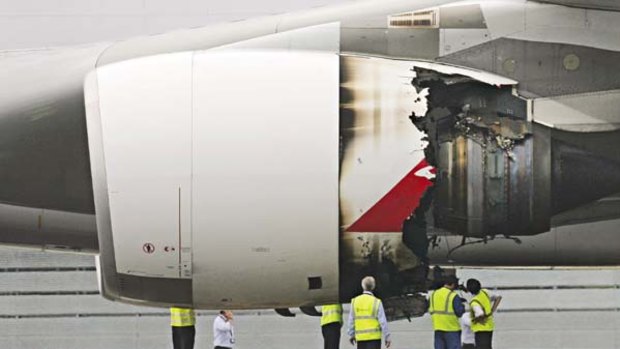
The damaged engine of the Qantas A380 passenger plane QF32 after it made an emergency landing at Changi airport on November 4, 2010.Credit: Reuters
The Qantas A380 that suffered a mid-air engine explosion about 18 months ago will return to the skies tomorrow after repairs costing $139 million.
The Nancy-Bird Walton will fly back to Sydney from Singapore following the work, which was paid for by insurance, said Qantas spokesman Thomas Woodward. The Airbus plane made an emergency landing in the city-state in November 2010 after one of its four Rolls-Royce engines exploded over Indonesia.
The A380, the first delivered to the Australian carrier, will resume commercial services on April 28, with a flight to Hong Kong, Woodward said. Its return will raise the carrier's active fleet of the 450-seat aircraft to 12, helping with plans to speed up the retirement of less fuel-efficient 747s.
"The older the aircraft are, the more you have to spend to keep them going," said Mark Williams, a Royal Bank of Scotland Group analyst in Sydney. "It's not just fuel costs, it's maintenance as well."
Qantas won $95 million in compensation from Rolls-Royce for disruptions caused by the incident, which prompted the carrier to ground its entire A380 fleet for more than three weeks. The costs associated with the accident are thus at least $234 million, more than the $220 million list price of a Boeing 787-9 Dreamliner.
Wait for repairs
Work on the Nancy-Bird Walton, which included rebuilding the engine and part of the plane's skin, took about eight months, Woodward said. The rest of the time, the aircraft, named after one of Australia's first female pilots, was sat at Singapore's Changi airport waiting for access to maintenance hangars, he said.
During the repairs, engineers also found hairline cracks in rib-feet used to support the plane's wings that were unrelated to the engine explosion. That helped prompt worldwide inspections and tighter checks on the global A380 fleet.
In the November 4, 2010 incident, part of the Nancy-Bird Walton's Rolls-Royce Trent 900 engine casing blew off shortly after takeoff from Singapore, sending shrapnel through a wing and fuselage, according to a preliminary report by the Australian Transport Safety Bureau. None of the 469 people on board were injured.
Fire in engine
The incident was caused by an oil leak and subsequent fire within the engine, according to the safety regulator. London- based Rolls-Royce subsequently revised procedures including ones for assessing new parts, it said.
Airbus spokesman Sean Lee said the planemaker wouldn't comment ahead of a Singapore press briefing today. Karun Arya, a Singapore-based spokesman for Rolls-Royce, didn't return a phone call seeking comment.
Chief Executive Officer Alan Joyce said in February that the airline will retire two more 747s in addition to four being phased out this month. The carrier had 20 jumbo jets as of June. Deliveries of 50 on-order 787s are also due to start next year.
Replacing the older aircraft will help pare fuel usage, after prices jumped more than 40 per cent in Singapore trading in two years. The airline still expects fuel costs to increase by $300 million in the six months through June from a year earlier because of higher prices and increased flying.
Bloomberg
Sign up for the Traveller newsletter
The latest travel news, tips and inspiration delivered to your inbox. Sign up now.